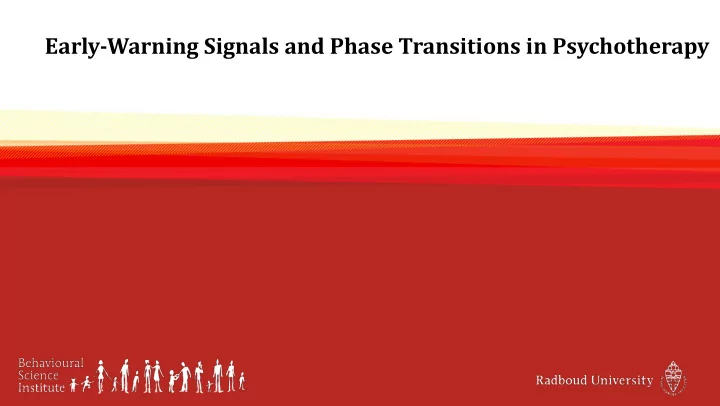

Early-Warning Signals and Phase Transitions in Psychotherapy
Early-warning signals for phase transitions Period of Instability Pre-transition Stable Post-transition Stable EWS - Critical Fluctuations - Critical Slowing Down Lichtwarck-Aschoff et al., 2012; Gelo & Salvatore, 2016; Scheffer et al., 2009
Instability is related to clinical improvement • Adults with mood disorders (Hayes & Strauss, 1998; Hayes & Yasinski, 2015; Van de Leemput et al., 2014; Schreuder et al. n.d.) • Adults with obsessive-compulsive disorders (Schiepek, Tominschek & Heinzel, 2014) • Adults with mixed diagnosis (Haken & Shiepek, 2006) • Children with aggression problems (Lichtwarck-Aschoff, Hasselman, … & Granic, 2012) • Children with anxiety problems (Lichtwarck-Aschoff & Van Rooij, 2019) Studies have small sample sizes or neglect possible destabilization periods during therapy.
Study 1: The relation between destabilization and treatment outcome Olthof, Hasselman, Strunk, Aas, Schiepek & Lichtwarck-Aschoff (2019) Destabilization in self-ratings of the psychotherapeutic process is associated with better treatment outcome in patients with mood disorders, Psychotherapy Research, DOI: 10.1080/10503307.2019.1633484 https://osf.io/fhrw4/
Design • Patients with mood disorders (N=328) • Collected with the Synergetic Navigation System 1 between 2008-2014 • Therapy Process Questionnaire (TPQ 2 ) - Factor I: Therapy progress - Factor II: Problem Intensity - Factor III: Relationship quality and trust in therapist - Factor IV: Dysphoric affect - Factor V: Relationship with fellow patients 1 Schiepek et al. (2016), 2 Haken & Schiepek (2010)
Data Collection • Collected in real-world psychiatric care setting with the SNS
Why daily self-ratings? Schiepek et al., 2016
Dynamic Complexity Schiepek & Strunk, 2010
Dynamic Complexity in a moving window Validation study: Schiepek & Strunk, 2010
Data Analysis • Peak Complexity (previous slide) • Treatment Duration • Problem Intensity (factor 2 of the TPQ) - Prescore: first week - Postscore: last week • Linear mixed-effects model 1 Schiepek et al. (2016), 2 Haken & Schiepek (2010)
Results
Conclusions • Patients with higher Peak Complexity have a stronger reduction in Problem Intensity • Destabilization periods that might seem obstructive in clinical observation may actually be beneficial for the patients change process, as these destabilization periods can result in a Phase Tranition towards clinical improvement • But can we use this knowledge for short-term prediction?
Study 2: Early-warning signals for sudden gains and losses Olthof, Hasselman, Strunk, van Rooij, Aas, Helmich, Schiepek & Lichtwarck-Aschoff (in press). Critical Fluctuations as an Early- Warning Signal for Sudden Gains and Losses in Patiens receiving Psychotherapy for Mood Disorders. Clinical Psychological Science. https://osf.io/fhrw4/
Analyses Individual level: • Sudden gains / losses* • Dynamic complexity Multi-level: • Survival analysis *Google scholar: ‘Ceulemans, change point analysis’ for an alternative approach, or ask Marieke!
Results and conclusions • A 1 standard deviation increase in dynamic complexity is related to a 55% increased change for a sudden gain or loss in the upcoming 4 days • Early-warning signals have a real-time predictive value for sudden gains and losses • Sudden gains and losses are likely to represent order transitions within a patient • Predictive early-warning signals can be used in clinical practice to identify periods of instability within a patient’s change process
Recommend
More recommend